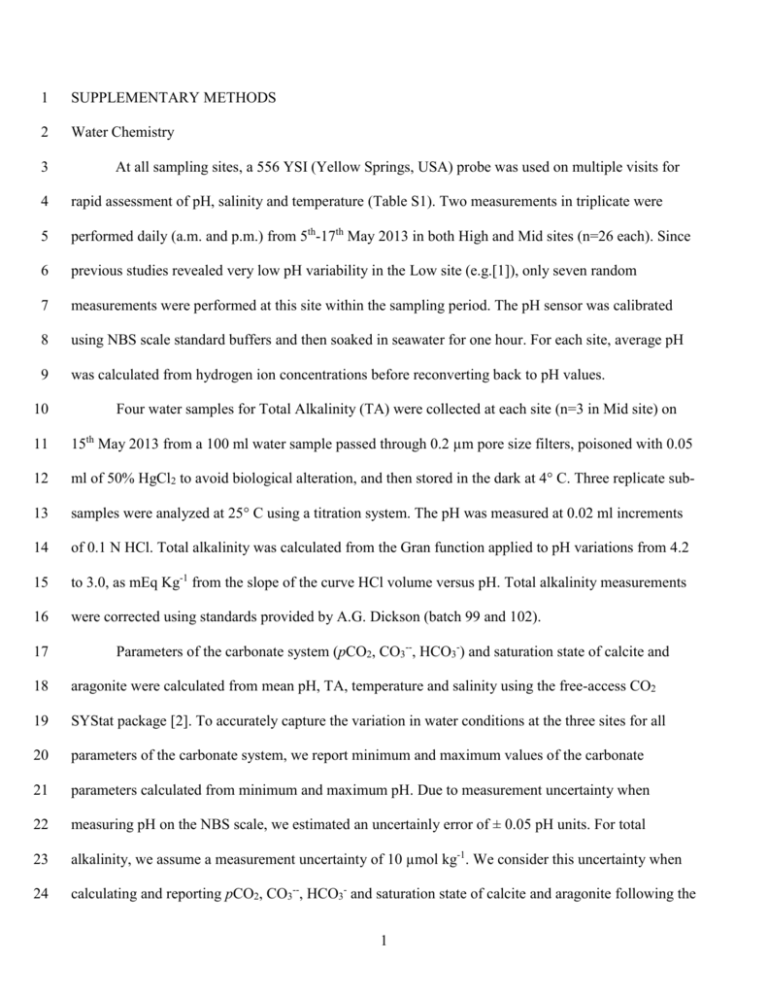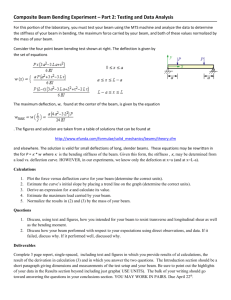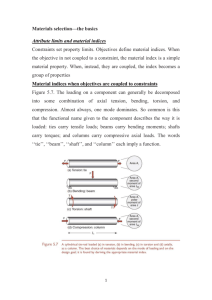SUPPLEMENTARY METHODS Water Chemistry At all sampling
advertisement

1 SUPPLEMENTARY METHODS 2 Water Chemistry 3 At all sampling sites, a 556 YSI (Yellow Springs, USA) probe was used on multiple visits for 4 rapid assessment of pH, salinity and temperature (Table S1). Two measurements in triplicate were 5 performed daily (a.m. and p.m.) from 5th-17th May 2013 in both High and Mid sites (n=26 each). Since 6 previous studies revealed very low pH variability in the Low site (e.g.[1]), only seven random 7 measurements were performed at this site within the sampling period. The pH sensor was calibrated 8 using NBS scale standard buffers and then soaked in seawater for one hour. For each site, average pH 9 was calculated from hydrogen ion concentrations before reconverting back to pH values. 10 Four water samples for Total Alkalinity (TA) were collected at each site (n=3 in Mid site) on 11 15th May 2013 from a 100 ml water sample passed through 0.2 µm pore size filters, poisoned with 0.05 12 ml of 50% HgCl2 to avoid biological alteration, and then stored in the dark at 4° C. Three replicate sub- 13 samples were analyzed at 25° C using a titration system. The pH was measured at 0.02 ml increments 14 of 0.1 N HCl. Total alkalinity was calculated from the Gran function applied to pH variations from 4.2 15 to 3.0, as mEq Kg-1 from the slope of the curve HCl volume versus pH. Total alkalinity measurements 16 were corrected using standards provided by A.G. Dickson (batch 99 and 102). 17 Parameters of the carbonate system (pCO2, CO3--, HCO3-) and saturation state of calcite and 18 aragonite were calculated from mean pH, TA, temperature and salinity using the free-access CO2 19 SYStat package [2]. To accurately capture the variation in water conditions at the three sites for all 20 parameters of the carbonate system, we report minimum and maximum values of the carbonate 21 parameters calculated from minimum and maximum pH. Due to measurement uncertainty when 22 measuring pH on the NBS scale, we estimated an uncertainly error of ± 0.05 pH units. For total 23 alkalinity, we assume a measurement uncertainty of 10 µmol kg-1. We consider this uncertainty when 24 calculating and reporting pCO2, CO3--, HCO3- and saturation state of calcite and aragonite following the 1 25 methods in the Guide to Best Practices [3] and using the sensitivity coefficients in [4] (Table S1). 26 Dissociation constants of H2CO3 and HCO3- were from [5] while that of HSO4- was from [6]. 27 Field Surveys 28 We sampled three sites along this gradient ranging from present day conditions (~600 m from 29 the main seeping area, hereafter referred to as the ‘Low’ site with a mean CO2 concentration of 418 30 µatm, Ωarag 3.56), a ‘Mid’ site (~400 m from the main seeping area, 638 µatm CO2, Ωarag 2.62) and a 31 ‘High’ site (~300 m from the main seeping area, 2283 µatm CO2, Ωarag 0.96) (Figure S1, Table S1). 32 Snorkel surveys were undertaken in March, May, September 2012, May 2013, and May 2014 to assess 33 the presence and appearance of A. acetabulum along the gradient. During the May 2014 survey, percent 34 cover was measured at three transects at each site (1-3 m depth), with 10 random 0.5 by 0.5 m photo- 35 quadrats in each transect. Acetabularia acetabulum samples were collected from the three sites in May 36 2013 for materials testing. 37 Mechanics: Beam Bending 38 We used static cantilever beam theory to quantify the mechanical performance of both the stem, 39 (a structure) and the material of which it is made. This technique has been applied to a wide variety of 40 marine organisms previously, from corals to algae to sea anemones, to better understand how these 41 organisms bend in response to flow (see [7] for example). In general, a beam will bend more under a 42 given load if is it longer, thinner, and/or made of less stiff material. The beam (a stem in this study) is 43 first clamped at one end and extends horizontally. A known force is applied at a known length from the 44 fixed end and the beam deflects downward. The degree to which the beam deflects for a given force 45 and length is known as its flexural stiffness, a mechanical property of the entire structure that depends 46 on beam cross sectional shape and material composition. Dividing flexural stiffness by second moment 47 of area gives the stiffness of the stem material, regardless of the beam shape. 2 48 Beam bending was quantified by hanging a weight (mass measured to the 10-4 g) on the stem to 49 exert a force (F, mass times gravitational acceleration in N) to deflect the algal beam 10-15% of its 50 length. Photographs were taken at a fixed distance with a scale before and after the weight was hung to 51 measure beam length (L, m) and vertical deflection of the point on the beam where the weight was 52 hung from its original position (y, m) to the nearest 10-6 m. 53 Mechanics: Second Moment of Area 54 55 The second moment of area, I (m4), is a measure of the distribution of area around a bending axis, in this case the minimum possible I for a hollow elliptical beam [8]: I = (π/4) (RM*Rm3)-(rM*rm3). 56 57 RM and Rm are the outer major and minor radii, respectively, and rM and rm are the inner major and 58 minor radii, respectively. Radii were measured from cross sections of each stem to the nearest 0.0001 59 mm using a scanning electron microscope. Stiffness (E), a material property, was calculated by 60 dividing flexural stiffness (EI) by second moment of area (I). 61 62 63 Statistics Percent cover was square root transformed and compared among sites with a one-way ANOVA. 64 The proportion of calcified tissue was compared among sites with a one-way ANOVA. When data 65 were not normally distributed, a Kruskal-Wallis test was used. When applicable, pairwise differences 66 between groups were determined using a Tukey’s HSD or Dunn test for parametric or non-parametric 67 post-tests, respectively. Flexural stiffness and stiffness did not meet the assumptions of normality and 68 were compared among sites with a Wilcoxon Signed-Rank test. Regression analysis was conducted to 69 describe the relationship between algal calcification and stiffness using linear, exponential and 70 polynomial models. The exponential curve was generated using a linear model on log-transformed data. 3 71 Standardized major axis (SMA) regression was used for the linear models. The most parsimonious 72 model with the lowest AIC (Akaike’s Information Criterion) was selected to describe the data (Table 73 S2). The raw data for this analysis is shown in Table S3. 74 4 75 76 77 Figure S1. Map of study site in Levante Bay (Baia levante) off of Vulcano Island, Sicily, Italy. 78 5 79 Table S1. Seawater carbonate chemistry along a pCO2 gradient off Vulcano (mean ± SD for salinity, 80 temperature, alkalinity; mean ± uncertainty for pH, pCO2, HCO3-, CO3--, Ω Aragonite 81 , Ω Calcite). From 5-17 May 2013, three sites at increasing distance from the main seeping area were 82 sampled along the gradient: High (n=26), Mid (n=26), and Low (i.e., ambient) CO2 levels (n=7). 83 Samples for total alkalinity analyses (n=4) were collected at each site on 15 May 2013. High Mid Low 280 390 640 Salinity 38.13 (±0.06) 38.1 (±0.06) 38.11 (±0.07) Temperature (˚C) 19.36 (±0.51) 19.35 (±0.45) 19.40 (±0.44) pHNBS 7.53 (±0.05) 8.03 (±0.05) 8.19 (±0.05) min – max 6.81 – 8.07 7.59 – 8.22 8.13 – 8.23 Total Alkalinity (µ mol kg-1) 2552 (±43) 2519 (±49) 2549 (±61) pCO2 (µatm) 2283 (±118) 638 (±37) 418 (±29) 547 (±28) – 12638 (±665) 378 (±22) – 1977 (±116) 370 (±26) – 490 (±34) 62 (±2) 172 (±7) 234 (±11) 12 (±1) – 189 (±7) 69 (±3) – 243 (±10) 211 (±10) – 252 (±12) 2400 (±36) 2102 (±35) 1981 (±40) 2092 (±31) – 2521 (±38) 1926 (±32) – 2350 (±39) 1937 (±39) – 2038 (±41) 0.96 (±0.03) 2.62 (±0.10) 3.56 (±0.17) 1.06 (±0.04) – 3.71(±0.14) 3.21 (±0.15) – 3.84 (±0.18) 4.02 (±0.16) 5.47 (±0.26) 1.62 (±0.06) – 5.70 (±0.22) 4.92 (±0.23) – 5.90 (±0.28) Distance from the vents (m) min - max CO3-- (µmol kg-1) min - max HCO3- (µmol kg-1) min - max Ω Aragonite min - max 0.19 (±0.01) – 2.89 (±0.10) Ω Calcite 1.47 (±0.05) min - max 0.29 (±0.01) – 4.43 (±0.15) 84 85 6 86 87 88 89 Table S2. Summary of regression analyses used to describe the relationship between stiffness, E, and proportion calcified, C (Figure 2C). See supplementary methods for details. The exponential curve was chosen because it had the lowest AIC. R2 P AIC E = 1.26 e 9.18 * C 0.51 < 0.001 2 2 E = 5738.2C-3009.9 0.16 0.03 391 3 E = 1113.6C2 +993.8C-315.4 0.16 0.11 461 Regression Parameters Equation Exponential 2 Linear Polynomial F 90 91 7 2.41 92 Table S3. Raw data for Figure 2C, stiffness (E, MPa) as a function of proportion calcified of the stem. Proportion Calcified 0.27174 0.43353 0.51948 0.57432 0.59091 0.59242 0.61017 0.63362 0.66292 0.67052 0.67279 0.71739 0.72353 0.72934 0.73057 0.73077 0.73444 0.73770 0.73929 0.74011 0.74346 0.74477 0.74914 0.76981 0.77236 0.77465 0.77500 0.77725 0.77846 E (MPa) 7.39 567.49 210.75 647.63 1131.39 337.08 208.15 1081.31 675.45 1443.84 343.64 777.51 993.66 945.03 2112.31 636.86 908 516.35 667.57 1040.4 1695.21 1165.71 864.43 3351.93 1448.04 607.82 422.89 433.36 515.69 93 94 8 95 Supplemental References 96 1. Boatta F, D'Alessandro W, Gagliano AL, Liotta M, Milazzo M, Rodolfo-Metalpa R, Hall-Spencer 97 JM, Parello F. 2013 Geochemical survey of Levante Bay, Vulcano Island (Italy), a natural laboratory 98 for the study of ocean acidification. Mar. Pollut. Bull. 73, 485–494. 99 (doi:10.1016/j.marpolbul.2013.01.029) 100 101 2. Pierrot D, Lewis E, Wallace DWR. 2006 MS Excel program developed for CO2 system calculations. 102 ORNL/CDIAC-105a. Carbon Dioxide Information Analysis Center, Oak Ridge National Laboratory, 103 U.S. Department of Energy, Oak Ridge, Tennessee. 104 (doi:10.3334/CDIAC/otg.CO2SYS_XLS_CDIAC105a) 105 106 3. Riebesell U, Fabry VJ, Hansson L, and Gattuso J-P. (Eds.), 2010. Guide to best practices for ocean 107 acidification research and data reporting, 260 p. Luxembourg: Publications Office of the European 108 Union 109 110 4. Dickson AG, Riley JP. 1978. The effect of analytical error on the evaluation of the components of 111 the aquatic carbon-dioxide system. Mar. Chem. 6, 77-85. 112 113 5. Roy RN, Roy LN, Vogel KM, Porter-Moore C. 1993 The dissociation constants of carbonic acid in 114 seawater at salinities 5 to 45 and temperatures 0 to 45 C. Mar. Chem. 44, 249–267. (doi:10.1016/0304- 115 4203(93)90207-5) 116 9 117 6. Dickson AG. 1990 Standard potential of the reaction: AgCl(s) + ½ H2(g) = Ag(s) + HCl(aq), and the 118 standard acidity constant of the ion HSO4− in synthetic sea water from 273.15 to 318.15 K. J. Chem. 119 Thermodyn. 22, 113–127. (doi:10.1016/0021-9614(90)90074-Z) 120 121 7. Demes KW, Harley CDG, Anderson LM, Carrington E. 2013 Shifts in morphological and 122 mechanical traits compensate for performance costs of reproduction in a wave-swept seaweed. J Ecol. 123 101, 963–970. (doi:10.1111/1365-2745.12099) 124 125 8. Myers, JA. 1962 Handbook of Equations for Mass and Area Properties of Various Geometrical 126 Shapes. U.S. Naval Ordnance Test Station, Publication 2838. China Lake, CA: Publishing Division 127 Technical Information Department. 128 129 10







